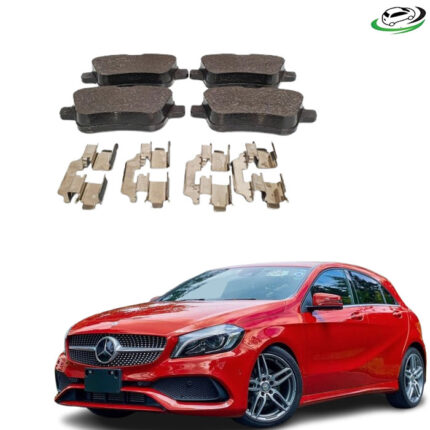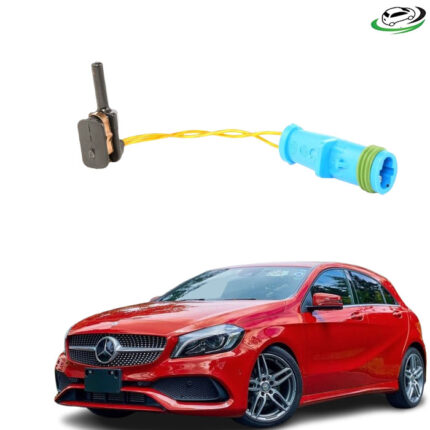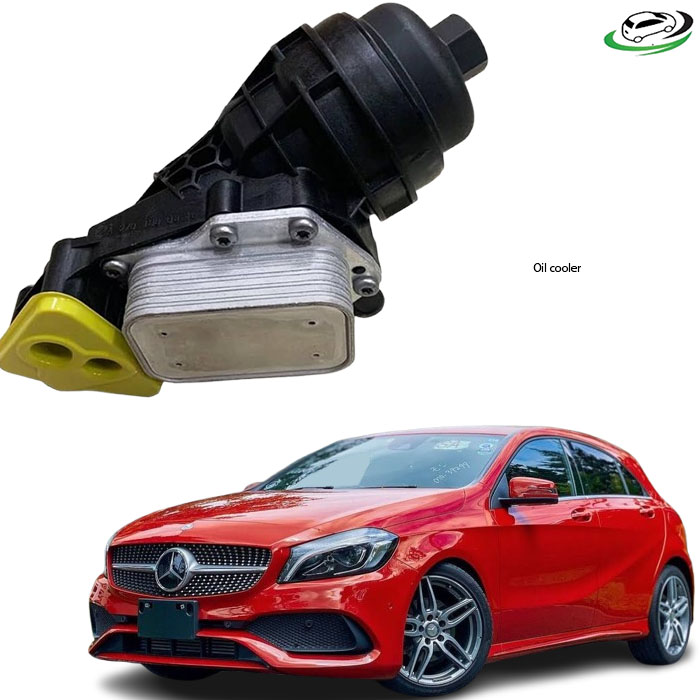-13%
Get Mercedes Benz A180 W176 Engine Oil Cooler Filter A2701800610 in Kenya
The engine is the heart of any vehicle, and its efficiency depends on a well-lubricated and cooled system. One of the essential components that ensure proper lubrication and cooling is the engine oil cooler filter. This component plays a dual role—filtering contaminants from the oil and aiding in temperature regulation to keep the engine running smoothly.
This detailed guide will explore the engine oil cooler filter, covering its function, types, benefits, signs of failure, maintenance tips, and replacement guidelines. Whether you’re a car enthusiast, a mechanic, or someone interested in learning more about automotive parts, this article will provide valuable insights into the importance of the engine oil cooler filter in vehicle performance and longevity.
What Is an Engine Oil Cooler Filter?
An engine oil cooler filter is a crucial part of the lubrication and cooling system in modern internal combustion engines. It removes impurities from the engine oil while also working alongside the oil cooler to regulate oil temperature. This ensures that the engine operates efficiently under various conditions without suffering from excess wear, overheating, or contamination.
Most vehicles, especially high-performance and heavy-duty models, use oil coolers to prevent excessive heat buildup. The oil cooler filter ensures that only clean, debris-free oil circulates through the cooler and engine components, enhancing the lifespan of the engine and maintaining optimal performance.
How an Engine Oil Cooler Filter Works
The engine oil cooler filter functions in two key ways:
1. Filtering Contaminants from the Oil
As engine oil circulates through the system, it picks up debris such as metal particles, carbon deposits, and dirt. These contaminants can cause wear and tear on engine components if not removed. The filter traps these impurities, ensuring that clean oil reaches critical engine parts.
2. Assisting in Oil Cooling
The oil cooler reduces the temperature of the engine oil to prevent overheating. However, dirty or clogged oil can reduce the cooling efficiency of the system. By keeping the oil clean, the filter helps maintain an optimal cooling effect, preventing issues like thermal breakdown and viscosity loss.
Step-by-Step Functioning of the Oil Cooler Filter:
- Oil Circulation: Engine oil flows from the oil pump through the filter before reaching the cooler and lubrication system.
- Filtration Process: The filter removes debris and contaminants, allowing only clean oil to pass through.
- Temperature Control: The filtered oil reaches the oil cooler, where excess heat is dissipated.
- Lubrication and Protection: Cooled and filtered oil circulates to vital engine components, reducing friction and enhancing performance.
Types of Engine Oil Cooler Filters
There are different types of oil cooler filters, designed based on engine requirements and vehicle specifications:
1. Spin-On Oil Cooler Filters
- Design: These are self-contained filters with a metal casing and built-in filtration element.
- Installation: Easy to replace—simply unscrew the old filter and screw in a new one.
- Common Use: Found in most passenger vehicles and light-duty trucks.
2. Cartridge Oil Cooler Filters
- Design: Consists of a replaceable filter element without an external metal casing.
- Installation: The filter sits inside a permanent housing, requiring only the filter media to be changed.
- Common Use: Found in modern and high-performance engines, often used for eco-friendly applications.
3. Magnetic Oil Cooler Filters
- Design: Uses magnetic force to attract metal particles from the oil.
- Benefit: Extends the lifespan of the filter by reducing clogging from metallic contaminants.
- Common Use: Found in high-performance and racing engines where metal debris is common.
4. High-Performance Synthetic Filters
- Design: Made with advanced synthetic fibers for enhanced filtration.
- Benefit: Provides superior filtration and lasts longer than traditional filters.
- Common Use: Used in sports cars, turbocharged engines, and heavy-duty trucks.
Benefits of an Engine Oil Cooler Filter
A high-quality engine oil cooler filter is essential for maintaining the health and efficiency of your engine. Here are some key benefits:
1. Enhanced Engine Longevity
- Removes harmful contaminants, preventing engine wear and damage.
- Reduces friction and heat, extending engine life.
2. Improved Oil Cooling Efficiency
- Allows for proper heat dissipation, preventing oil breakdown.
- Ensures consistent lubrication even under extreme conditions.
3. Reduced Maintenance Costs
- Keeps oil clean and effective, reducing the frequency of oil changes.
- Prevents premature engine failures, saving money on major repairs.
4. Increased Fuel Efficiency
- Clean oil ensures the engine operates smoothly and efficiently.
- Reduces drag on engine components, leading to better fuel economy.
Signs of a Failing Engine Oil Cooler Filter
A malfunctioning oil cooler filter can lead to serious engine issues. Here are some signs that indicate a failing filter:
1. Reduced Oil Pressure
- A clogged filter can restrict oil flow, causing low oil pressure.
- Warning lights may appear on the dashboard indicating low oil pressure.
2. Overheating Engine
- Dirty oil reduces the cooling efficiency of the oil cooler.
- If the engine temperature is higher than normal, it may indicate a failing filter.
3. Contaminated or Dark Oil
- If the engine oil appears thick, dark, or gritty, it may signal poor filtration.
- Check the oil dipstick regularly for signs of contamination.
4. Poor Engine Performance
- If the engine feels sluggish, lacks power, or runs roughly, the filter may be clogged.
- Dirty oil can cause increased friction, affecting engine smoothness.
5. Increased Exhaust Smoke
- A malfunctioning filter may allow burnt oil to escape, leading to excessive exhaust smoke.
- This can indicate oil contamination or overheating.
Maintenance Tips for Engine Oil Cooler Filters
Proper maintenance ensures that your oil cooler filter performs effectively. Here are some best practices:
1. Regularly Replace the Oil Cooler Filter
- Follow the manufacturer’s recommendation for oil and filter changes (typically every 5,000-10,000 miles).
- Frequent oil changes keep the filter working efficiently.
2. Use High-Quality Engine Oil
- Synthetic or manufacturer-recommended oil improves filtration and cooling.
- Low-quality oil can clog the filter prematurely.
3. Inspect for Leaks
- Look for oil leaks around the filter housing or oil cooler.
- Leaks can indicate a damaged filter seal or improper installation.
4. Monitor Oil Pressure
- Use the dashboard gauge to check for consistent oil pressure.
- If oil pressure fluctuates, inspect the filter for clogging.
5. Keep the Oil Cooler Clean
- Dirt buildup on the oil cooler can reduce heat dissipation.
- Regularly inspect and clean the cooler to maintain performance.
Replacing an Engine Oil Cooler Filter
When replacing an oil cooler filter, follow these steps:
- Lift the Vehicle – Ensure safety with jack stands.
- Drain the Engine Oil – Prevent contamination when removing the old filter.
- Remove the Old Filter – Use an oil filter wrench to loosen and remove it.
- Install the New Filter – Apply a thin layer of oil to the new filter’s gasket before installation.
- Refill with Fresh Oil – Pour the correct oil type and quantity.
- Check for Leaks – Start the engine and check for leaks.
- Monitor Performance – Drive the vehicle and observe for any issues.
Conclusion
The engine oil cooler filter is a critical component in ensuring clean, well-cooled oil circulates through the engine. It enhances engine longevity, cooling efficiency, and overall performance. Regular maintenance, using quality oil and filters, and replacing the filter at recommended intervals help prevent costly repairs and keep your engine running smoothly. Prioritizing this small yet vital component ensures optimal engine protection and efficiency, making it an essential part of vehicle care.
Follow us on Facebook for more parts.




Reviews
Clear filtersThere are no reviews yet.